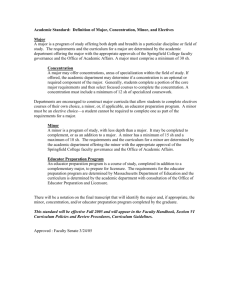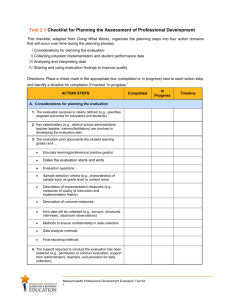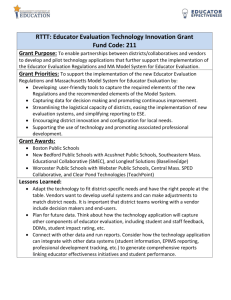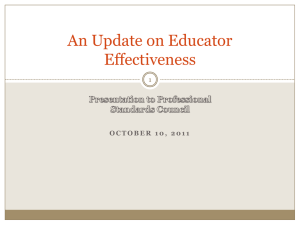Readiness Tool
advertisement
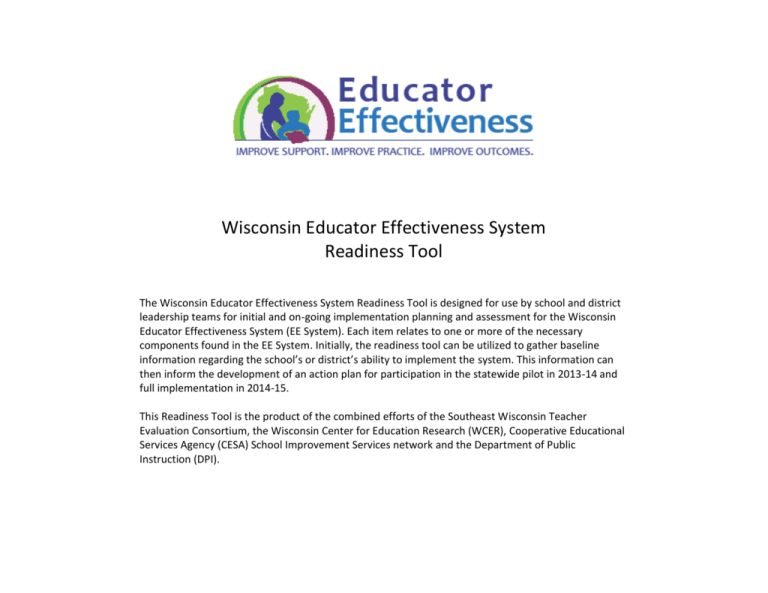
Wisconsin Educator Effectiveness System Readiness Tool The Wisconsin Educator Effectiveness System Readiness Tool is designed for use by school and district leadership teams for initial and on-going implementation planning and assessment for the Wisconsin Educator Effectiveness System (EE System). Each item relates to one or more of the necessary components found in the EE System. Initially, the readiness tool can be utilized to gather baseline information regarding the school’s or district’s ability to implement the system. This information can then inform the development of an action plan for participation in the statewide pilot in 2013-14 and full implementation in 2014-15. This Readiness Tool is the product of the combined efforts of the Southeast Wisconsin Teacher Evaluation Consortium, the Wisconsin Center for Education Research (WCER), Cooperative Educational Services Agency (CESA) School Improvement Services network and the Department of Public Instruction (DPI). Educator Knowledge of the Educator Effectiveness System Not in Place (NP) No activity occurring in this area Purpose Building (PB) Identifying needs Exploring options Building background knowledge Answering why Increasing awareness Learning about Action Planning (A) Articulating and defining new skills Training Answering what, where, who, when & how Implementation (I) Putting plans into action Doing the work Monitoring for fidelity Providing resources Changes in staff practice Providing clarity Refinement (R) Adapting practice to local context while maintaining fidelity Building habits and routines Directions: Read each of the items listed below and determine the appropriate level for your school/district. All district leaders understand the Educator Effectiveness System and can clearly articulate why it is needed, how it will be implemented, and its potential impact. NP PB A I R All principals understand the Educator Effectiveness System and can articulate why it is needed, how it will be implemented, and its potential impact. NP PB A I R All teachers understand the Educator Effectiveness System and can articulate why it is needed, how it will be implemented, and its potential impact. NP PB A I R All teachers and their evaluators understand the process for teacher evaluations. NP PB A I R All principals and their evaluators understand the process for principal evaluations. NP PB A I R All teachers understand the student outcome measures of the Educator Effectiveness System relevant to their position. NP PB A I R All principals understand the student outcome measures of the Educator Effectiveness System relevant to their position. NP PB A I R Wisconsin Educator Effectiveness Readiness Tool 2 Potential Growth Strategies to Build Educator Knowledge of the Educator Effectiveness System Clarify your district mission and vision as they relate to the basic purpose of an educator evaluation system Investigate Educator Effectiveness models and select the one with the strongest research base that most closely aligns with your identified mission and vision Facilitate overview sessions to build understanding among all staff Create common tools for principals to share information with teachers (i.e., standard PowerPoint, information sheets, etc.) Message the idea that this is about improving practice and expanding highly effective teaching Develop a district-specific FAQ to help with understanding Action Step Wisconsin Educator Effectiveness Readiness Tool Timeline Create a visual that clarifies the flow of the process in your district Have educators unwrap the standards for educator performance (InTASC or ISLLC)--dig in, what do they mean, what would be evidence of performance (i.e. what do I already do?) Build understanding of the link between the InTASC and ISLLC standards, and the Educator Effectiveness model selected by your district Compare and contrast your current system with new system Determine what outcome measures are already in place and where work will be needed Evidence of Implementation 3 Capacity and Infrastructure Not in Place (NP) No activity occurring in this area Purpose Building (PB) Identifying needs Exploring options Building background knowledge Answering why Increasing awareness Learning about Action Planning (A) Articulating and defining new skills Training Answering what, where, who, when & how Implementation (I) Putting plans into action Doing the work Monitoring for fidelity Providing resources Changes in staff practice Providing clarity Refinement (R) Adapting practice to local context while maintaining fidelity Building habits and routines Directions: Read each of the items listed below and determine the appropriate level for your school/district. The school/district has a clearly defined timeline and process for teacher/principal evaluations. NP PB A I R Educators and evaluators will receive initial and ongoing training on the Educator Effectiveness system. NP PB A I R All teachers and their evaluators understand the timeline for teacher evaluation and have integrated it into their schedules and workloads. NP PB A I R All principals and their evaluators understand the timeline for principal evaluation and have integrated it into their schedules and workloads. NP PB A I R A sufficient number of evaluators are in place to effectively evaluate and provide feedback to all educators. NP PB A I R Personnel have been identified to manage the Educator Effectiveness system at the district level (e.g., human resources, assessment and accountability, information technology). NP PB A I R Personnel have been identified to provide district-level support on the Educator Effectiveness system (e.g., human resources, assessment and accountability, information technology, student services, curriculum and instruction). NP PB A I R District personnel have been identified to provide school-level support on the Educator Effectiveness system (e.g., human resources, assessment and accountability, information technology, student services, curriculum and instruction). NP PB A I R Wisconsin Educator Effectiveness Readiness Tool 4 A district Educator Effectiveness lead has been identified to coordinate overall implementation. NP PB A I R School level leads have been identified to support the Educator Effectiveness system within schools and to coordinate with the district lead. NP PB A I R A plan is in place to monitor and improve evaluator consistency on providing feedback and rater agreement. NP PB A I R Potential Growth Strategies to Build Capacity and Infrastructure Map district/school plan for professional development related to ALL of the Agenda 2017 (educator effectiveness, etc.) Develop a long range PD plan for initial and ongoing training for all evaluators and educators Identify who leads overall implementation efforts and monitor implementation progress (district and school level leaders) Plan sufficient initial training-build capacity with principals and educators Develop a clear timeline for your EE system Action Step Wisconsin Educator Effectiveness Readiness Tool Timeline Have a plan for routine follow-through (standing item on meeting agenda, adding this to your district dashboard) Identify the resource people who will do evaluations and provide support (peer coaches, expert coaches, administration, etc.) Develop protocols and/or guidelines to ensure consistent implementation across schools (e.g., quality standards for SLOs, timing of evidence collection) Determine process and structure for routine calibration (bringing on new staff members, etc.) to ensure consistency and reliability Evidence of Implementation 5 Communication and Stakeholder Engagement Not in Place (NP) No activity occurring in this area Purpose Building (PB) Identifying needs Exploring options Building background knowledge Answering why Increasing awareness Learning about Action Planning (A) Articulating and defining new skills Training Answering what, where, who, when & how Implementation (I) Putting plans into action Doing the work Monitoring for fidelity Providing resources Changes in staff practice Providing clarity Refinement (R) Adapting practice to local context while maintaining fidelity Building habits and routines Directions: Read each of the items listed below and determine the appropriate level for your school/district. The district has engaged their internal and external stakeholders in the Educator Effectiveness system. NP PB A I R The district has strategies in place to effectively communicate important milestones and progress to internal audiences, including both proactive and responsive tactics. NP PB A I R The district has strategies in place to effectively communicate important milestones and progress to external audiences (parents, community leaders, media), including both proactive and responsive tactics. NP PB A I R A point person has been identified to lead district communications about the Educator Effectiveness system. NP PB A I R Feedback mechanisms for both internal and external audiences have been identified, monitored, and acted upon. NP PB A I R Wisconsin Educator Effectiveness Readiness Tool 6 Potential Growth Strategies to Increase Communication and Stakeholder Engagement Write a series of brief articles for the local newspaper (Facebook page, television, radio, etc.) to inform public of initiative (control the message---this isn't about "gotcha;" it's about "getting better") Include teacher-leaders as you plan for Educator Effectiveness Create a message map Provide routine updates to teachers and the Board of Education Frame presentation/conversation with PTO, site councils, etc. Action Step Wisconsin Educator Effectiveness Readiness Tool Timeline Create talking points to share with staff Consider this as an opportunity to have significant impact on educational practice and results in student learning Help people understand the "why" behind this initiative...not just the “what” or "hows"...create the compelling reason for this change...the tone you set with this as district leaders will be the tone that permeates the organization Evidence of Implementation 7 Resources Not in Place (NP) No activity occurring in this area Purpose Building (PB) Identifying needs Exploring options Building background knowledge Answering why Increasing awareness Learning about Action Planning (A) Articulating and defining new skills Training Answering what, where, who, when & how Implementation (I) Putting plans into action Doing the work Monitoring for fidelity Providing resources Changes in staff practice Providing clarity Refinement (R) Adapting practice to local context while maintaining fidelity Building habits and routines Directions: Read each of the items listed below and determine the appropriate level for your school/district. The district/school has identified the costs associated with implementing the Educator Effectiveness System (such as data system development, evaluation training, lowering the evaluator/educator ratio). NP PB A I R The district/school has identified resources needed to implement the Educator Effectiveness System. NP PB A I R The district/school has allocated resources to cover costs associated with implementing the Educator Effectiveness System. NP PB A I R Wisconsin Educator Effectiveness Readiness Tool 8 Potential Growth Strategies to Analyze and Manage Resources Conduct a cost analysis for EE implementation Analyze time requirements for evaluators and participants Create a plan in response to time/cost analyses Action Step Wisconsin Educator Effectiveness Readiness Tool Timeline Have a system to use data to measure the effect of professional development on student achievement Increase professional development to plan and allocate resources for long term implantation Evidence of Implementation 9 Technology Not in Place (NP) No activity occurring in this area Purpose Building (PB) Identifying needs Exploring options Building background knowledge Answering why Increasing awareness Learning about Action Planning (A) Articulating and defining new skills Training Answering what, where, who, when & how Implementation (I) Putting plans into action Doing the work Monitoring for fidelity Providing resources Changes in staff practice Providing clarity Refinement (R) Adapting practice to local context while maintaining fidelity Building habits and routines Directions: Read each of the items listed below and determine the appropriate level for your school/district. The district is aware of the data needed for collection, storage, and access to facilitate educator effectiveness decisions. NP PB A I R The district has adequate technological infrastructure to implement the Educator Effectiveness System. NP PB A I R A plan is in place to verify student-teacher-course linkages necessary for educator effectiveness outcome measures. NP PB A I R Educators and their evaluators have adequate technology to implement the Educator Effectiveness System. NP PB A I R Educators and their evaluators have access to all necessary online tools for the evaluation process. NP PB A I R Data storage needs for the Educator Effectiveness System have been identified and a data quality plan has been developed. NP PB A I R Wisconsin Educator Effectiveness Readiness Tool 10 Potential Growth Strategies to Analyze and Manage Technology Identify person to take lead on technology Evaluators have adequate technology expertise Evaluators have adequate training on use of hand-held technologies Action Step Wisconsin Educator Effectiveness Readiness Tool Timeline Determine technology needs for Educator Effectiveness Support Educator Effectiveness in Technology plan Evidence of Implementation 11 Goal Setting Not in Place (NP) No activity occurring in this area Purpose Building (PB) Identifying needs Exploring options Building background knowledge Answering why Increasing awareness Learning about Action Planning (A) Articulating and defining new skills Training Answering what, where, who, when & how Implementation (I) Putting plans into action Doing the work Monitoring for fidelity Providing resources Changes in staff practice Providing clarity Refinement (R) Adapting practice to local context while maintaining fidelity Building habits and routines Directions: Read each of the items listed below and determine the appropriate level for your school/district. Teachers currently engage in a goal setting process that targets both professional practice and student learning; progress towards goals is monitored. NP PB A I R Principals currently engage in a goal setting process that targets both professional practice and student learning; progress towards goals is monitored. NP PB A I R School-based goals (i.e., within School Improvement Plans) and strategies for meeting the goals have been developed and are regularly monitored. NP PB A I R Wisconsin Educator Effectiveness Readiness Tool 12 Potential Growth Strategies to Advance Goal Setting Goals are written as SMART goals School Improvement plans are evidenced at classroom level Student growth data is analyzed and incorporated in goal development Action Step Wisconsin Educator Effectiveness Readiness Tool Timeline Student survey data is included in goal setting process Develop and implement a plan to monitor district, school and gradelevel goals Use rubrics to monitor goals Evidence of Implementation 13 Student Assessments Not in Place (NP) No activity occurring in this area Purpose Building (PB) Identifying needs Exploring options Building background knowledge Answering why Increasing awareness Learning about Action Planning (A) Articulating and defining new skills Training Answering what, where, who, when & how Implementation (I) Putting plans into action Doing the work Monitoring for fidelity Providing resources Changes in staff practice Providing clarity Refinement (R) Adapting practice to local context while maintaining fidelity Building habits and routines Directions: Read each of the items listed below and determine the appropriate level for your school/district. The district/school provides staff development regarding high-quality student assessment development. NP PB A I R The district/school regularly uses common assessments as evidence of student learning. NP PB A I R The district/school regularly analyzes student assessment data to guide and inform instruction. NP PB A I R Wisconsin Educator Effectiveness Readiness Tool 14 Potential Growth Strategies for Using Student Assessments Conduct an inventory of current assessments Survey staff to determine their needs in assessment literacy and data analysis. Plan professional development to meet identified needs. Conduct professional development on generating common formative and summative assessments for each course and grade based upon common learning targets Begin to identify plan for determining effectiveness/success of professional development Establish routine time on the calendar for the development and refinement of common assessments Action Step Wisconsin Educator Effectiveness Readiness Tool Timeline Encourage the use of student self-assessment in the balanced assessment system Leaders keep pulse on progress related to the administration of common assessments, analysis of results and use of data to inform instruction Establish routine structures (PLCs, etc.) to analyze results of common assessments and plan for instruction based upon those results Conduct data retreats to monitor growth and effectiveness of instruction and the school improvement plan Evidence of Implementation 15 Feedback System Not in Place (NP) No activity occurring in this area Purpose Building (PB) Identifying needs Exploring options Building background knowledge Answering why Increasing awareness Learning about Action Planning (A) Articulating and defining new skills Training Answering what, where, who, when & how Implementation (I) Putting plans into action Doing the work Monitoring for fidelity Providing resources Changes in staff practice Providing clarity Refinement (R) Adapting practice to local context while maintaining fidelity Building habits and routines Directions: Read each of the items listed below and determine the appropriate level for your school/district. Teachers and principals are provided on-going formative feedback regarding teacher/principal practice on a regular basis. NP PB A I R Teacher and principal professional development is based on data and feedback from the teacher/principal evaluation process. NP PB A I R Wisconsin Educator Effectiveness Readiness Tool 16 Potential Growth Strategies to Build a Feedback System Determine a system and schedule for regular classroom walkthroughs and process for giving feedback on those walkthroughs Provide professional development for evaluators on what high quality instruction looks like Provide professional development for evaluators on how to provide effective feedback Initiate discussion about how Educator Effectiveness data can be used for goal setting Action Step Wisconsin Educator Effectiveness Readiness Tool Timeline Cultivate a culture of continuous improvement and educator selfreflection Analyze Educator Effectiveness data on an individual, school, and district basis Provide opportunities for targeted professional development based on this data analysis Identify professional development resources (coaches, mentors, CESAs, institutes of higher ed, in-house expertise within the district) Evidence of Implementation 17

